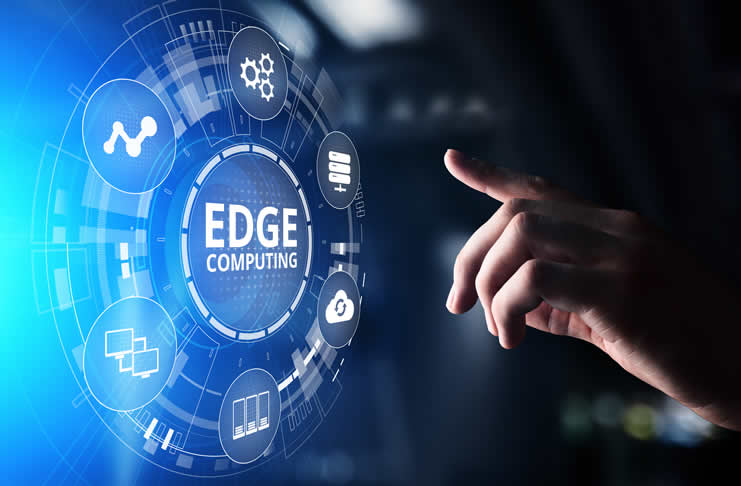Edge computing is a collaborative computing paradigm that reduces reaction times and bandwidth usage by moving computation as well as data storage closer to the point of demand.
Edge computing is becoming increasingly important for businesses as they seek to process and analyze large amounts of data in real time. By reducing latency and improving the speed and reliability of data processing, edge computing can help businesses improve their operations, enhance their customer experiences, and gain a reasonable advantage in the marketplace. This article will let us explore the benefits of edge computing and why it is considered the future of business operations.
WHAT IS EDGE COMPUTING?
Edge computing, a distributed computing paradigm, minimizes latency, maximizes network bandwidth, and permits real-time data processing by moving computer resources closer to the edge of the network.
In contrast to cloud computing, edge computing processes data closer to the data source. Cloud computing involves processing data on distant servers.
Edge computing benefits include reduced latency, enhanced data security, lessened network congestion, enhanced application performance, and cost savings.
EXAMPLES OF EDGE COMPUTING EXAMPLES
Edge computing has a wide range of applications in different fields. Here are some examples:
- SMART HOMES
The way people connect with their homes is changing thanks to edge computing. Smart homes may interpret data in real time and control and automate various aspects of the home environment by utilizing edge computing. Smart security systems, for instance, may keep an eye out for any strange activity in the house, while smart thermostats can regulate the temperature based on user behavior.
- AUTONOMOUS VEHICLES
The autonomous car ecosystem lacks edge computing. Autonomous vehicles can make judgments in real-time based on their environment by analyzing data at the edge. To detect and react to roadblocks, for instance, an autonomous vehicle can employ edge computing to analyze data from cameras and lidar sensors.
- INDUSTRIAL AUTOMATION
Industrial automation is being revolutionized by edge computing. Manufacturing facilities can lower latency and boost the effectiveness of their operations by processing data at the edge. Edge computing, for instance, can be used on an assembly line to assess sensor data and modify robot speed and movement to increase productivity.
WHAT IS EDGE COMPUTING ACCENTURE?
Global professional services company Accenture offers a variety of services, including consulting, technology, and digital transformation. They have created a thorough strategy for edge computing after identifying it as a crucial technology for accelerating digital transformation.
Accenture’s edge computing approach places emphasis on innovation, teamwork, and partnerships. They want to create cutting-edge edge computing technologies that help businesses decide more quickly and accurately. They work together with tech partners like Microsoft and AWS to provide edge computing solutions that are customized to the individual requirements of their customers.
Moreover, Accenture has a group of specialists who are focused on creating edge computing solutions. These experts have a deep understanding of edge computing technologies, such as 5G networks, and are able to deliver solutions that are scalable, secure, and reliable.
IMPORTANCE OF EDGE COMPUTING FOR DIGITAL TRANSFORMATION
Edge computing is becoming increasingly important for digital transformation. With the uprising number of the Internet of Things (IoT), businesses are generating more data than ever before. With the help of edge computing, organizations can analyze this data more quickly and effectively by doing so near where it is generated.
Businesses may also make quicker and more informed decisions thanks to edge computing. Businesses can make decisions in real-time based on the most recent data by processing data at the edge. This can be especially crucial in fields like healthcare, where decisions can directly affect patient outcomes.
Accenture incorporates edge computing into its digital transformation services because they understand how important it is for digital transformation. They assist their clients in determining the applications where edge computing may add the most value and create tailored edge computing solutions to match their individual requirements.
IDEAL SCENARIO FOR USING EDGE COMPUTING SOLUTIONS
The ability of edge computing solutions to handle data in real time with minimal latency is causing them to gain popularity across a variety of industries. In this section, we’ll go over the perfect situations in which to use edge computing tools to streamline corporate processes.
- LOW-LATENCY SOFTWARE
Applications requiring minimal latency, or the amount of time it takes for data to move from its source to its destination, are best served by edge computing. Edge computing has the potential to provide substantially faster reaction times than standard cloud computing in situations like real-time monitoring or control of machinery.
- PROCESSING DATA IN REAL TIME
Edge computing is perfect for applications that call for immediate analysis and response since it can process data in real time. Edge computing, for instance, may evaluate sensor data in real-time in a factory setting to find equipment defects and start preventive maintenance.
- HIGH-SECURITY STANDARDS
Edge computing has the potential to improve security in situations involving sensitive data. At the edge, data can be processed and analyzed, lowering the possibility of security breaches or unwanted access. For instance, edge computing can be utilized in the healthcare industry to handle patient data safely and in accordance with legal regulations.
RECENT INNOVATION IN EDGE COMPUTING ENHANCED BY 5G
As businesses continue to adopt edge computing solutions, the emergence of 5G technology has presented new opportunities for even faster and more efficient data processing. In this section, we will explore how 5G technology is enhancing edge computing and revolutionizing various industries through recent innovations.
- INTRODUCTION TO 5G
Fifth-generation wireless technology, or 5G, is the latest iteration of mobile network connectivity. It is truly a game-changer in the world of edge computing as it enhances the speed, reliability, and efficiency of data transmission and opens up a new arena of possibilities for businesses.
- BENEFITS OF 5G FOR EDGE COMPUTING
5G has several benefits that make it the perfect match for edge computing. First, 5G offers faster data transfer speeds than previous generations, reducing latency and enabling real-time data processing at the edge. Second, it provides more reliable connectivity, making it possible for businesses to deploy edge computing solutions in remote areas or mobile settings. Third, 5G is more energy-efficient, allowing for longer battery life for edge devices.
- EXAMPLES OF RECENT INNOVATIONS IN EDGE COMPUTING ENHANCED BY 5G
- Augmented and Virtual Reality Applications
The combination of 5G and edge computing has unlocked new possibilities in augmented and virtual reality. For example, 5G-powered AR applications can provide immersive experiences in real-time, while edge computing can help to process data closer to the user’s device, reducing latency and enhancing the experience.
- Autonomous Vehicles
Autonomous vehicles are becoming more common, and edge computing is a critical component in ensuring they function efficiently and safely. 5G can help to provide real-time updates on traffic and road conditions, while edge computing can process this data closer to the vehicle, enabling faster decision-making.
- Smart Cities
5G and edge computing are transforming cities into smart cities by enabling the deployment of IoT devices and sensors. With edge computing, data from these devices can be processed in real-time, providing city officials with valuable insights into traffic patterns, air quality, and other factors that impact citizens’ lives.
Edge computing and 5G are potent forces that are transforming business practices in a variety of industries. We may anticipate additional cutting-edge edge computing use cases boosted by 5G in the future as technology progresses.
OVERALL
In summary, edge computing is a crucial aspect of digital transformation that enables businesses to process data in real time, improve operational efficiency, and enhance customer experience. By leveraging edge computing solutions, organizations can overcome the limitations of cloud computing and capitalize on the benefits of low-latency applications, real-time data processing, and high-security requirements. The examples of edge computing applications in smart homes, autonomous vehicles, and industrial automation demonstrate the versatility of this technology in various industries. Accenture’s approach to edge computing further highlights the significance of this technology for digital transformation.
RECOMMENDATIONS
Edge computing technologies and their possible influence on operations must be taken into account as businesses continue to embrace digital transformation. Organizations should identify the parts of their operations that need real-time data processing and low-latency applications before implementing edge computing solutions. Also, they need to evaluate their current infrastructure to see if it can accommodate edge computing and, if not, upgrade as necessary. Partnerships with edge computing solution providers can also assist companies in utilizing the most recent developments and maintaining a competitive edge. Visit https://www.se.com/th/en/ for edge computing technology.
This edge computing technology is a game-changer for businesses that seek to improve operational efficiency, increase productivity, and enhance customer experience. Its benefits are numerous and cannot be overlooked in the digital age. By adopting edge computing solutions, businesses can stay ahead of the curve and build a competitive advantage.








